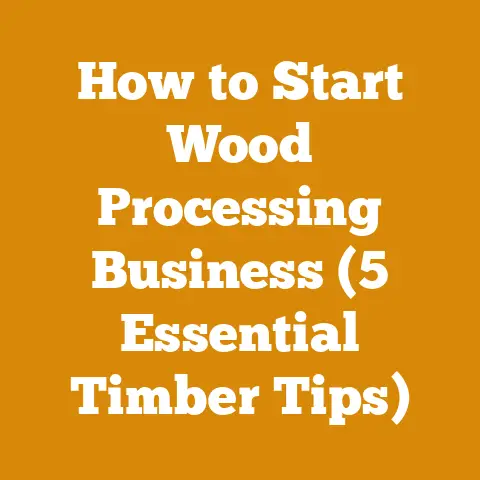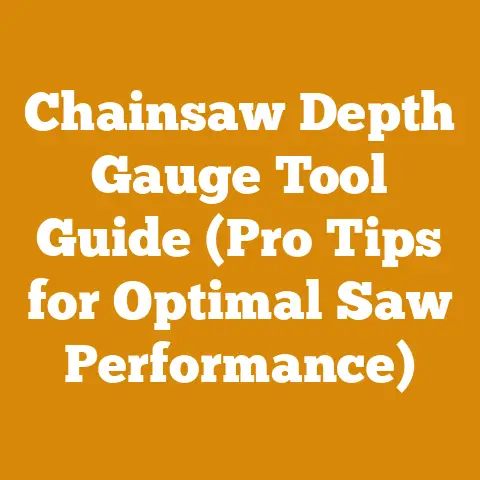Sapling Cutter Guide: Best Tools for Thick Undergrowth (5 Pro Tips)
Here in the Pacific Northwest, where I’ve spent years wrestling with tangled salal, thorny blackberry bushes, and dense thickets of alder saplings, I know firsthand the frustration of trying to clear stubborn undergrowth. It’s a battle against nature’s persistence, a test of both your tools and your grit. Globally, the challenges are similar, whether you’re in the Australian bush battling invasive species or clearing land for agroforestry in the Amazon. This guide is born from those experiences, designed to arm you with the knowledge and tools to conquer even the most challenging undergrowth.
The global forestry and logging industry is a significant economic driver, with a market size estimated at over $1.3 trillion USD in 2023 and projected to grow. A substantial portion of this involves managing undergrowth, not just for timber harvesting but also for wildfire prevention and ecosystem restoration. Managing saplings, brush, and invasive species is crucial for forest health and productivity, and selecting the right tools makes all the difference.
In this guide, I’ll share five pro tips, learned through trial and error (and a few battle scars!), to help you select the best tools for the job. We’ll dive deep into the pros and cons of various options, from manual tools like brush axes and loppers to powered solutions like chainsaws and brush cutters. I’ll also cover safety considerations, maintenance tips, and even some budget-friendly strategies to make your undergrowth clearing projects more efficient and effective.
Understanding the Undergrowth Challenge
Before we dive into the tools, let’s clarify what we mean by “thick undergrowth.” This term encompasses a wide range of vegetation, including:
- Saplings: Young trees, typically less than 4 inches in diameter.
- Bushes and Shrubs: Dense, woody plants that can form impenetrable thickets.
- Vines: Creeping or climbing plants that can strangle other vegetation.
- Brambles: Thorny plants like blackberry, raspberry, and rose bushes.
The density, species, and terrain will all influence your tool selection. For example, clearing a flat area of soft, new growth will be vastly different from tackling a steep hillside covered in mature, thorny bushes.
Pro Tip #1: Assess the Situation and Plan Your Attack
The first, and arguably most crucial, step is to assess the undergrowth you’re facing. Don’t just jump in swinging! Ask yourself these questions:
- What species are you dealing with? Some species are easier to cut than others. Softwood saplings like pine or fir are generally easier than hardwood saplings like oak or maple. Thorny bushes require specialized tools and protective gear.
- What is the density of the undergrowth? Is it a scattered collection of saplings or a solid wall of vegetation? This will determine the power and reach you need.
- What is the terrain like? Is it flat, sloped, rocky, or uneven? This will influence the maneuverability and safety of your tools.
- What is the desired outcome? Are you clearing a firebreak, creating a walking path, or prepping land for planting? This will dictate the level of clearing required.
Once you have a clear understanding of the situation, you can develop a plan of attack. This plan should include:
- Tool selection: Based on the species, density, and terrain, choose the appropriate tools.
- Safety precautions: Identify potential hazards and implement safety measures (more on this later).
- Clearing strategy: Determine the most efficient way to clear the undergrowth, considering factors like direction of cut, disposal methods, and potential obstacles.
Example: I once tackled a project clearing a dense patch of Himalayan blackberry that had completely engulfed a small orchard. After assessing the situation, I realized that a combination of loppers for initial cutting, a brush axe for thicker stems, and a heavy-duty brush cutter for the remaining roots was the most effective approach. Without a plan, I would have wasted time and energy using the wrong tools.
Pro Tip #2: Master the Manual Tools – The Silent Warriors
Manual tools are often overlooked in favor of their powered counterparts, but they are invaluable for certain tasks. They are quiet, lightweight, require no fuel, and offer a level of precision that power tools can’t match. Here are some of my go-to manual tools for undergrowth clearing:
Loppers: These are essentially oversized pruning shears, ideal for cutting branches and stems up to 2 inches in diameter. Look for loppers with long handles for increased leverage and compound action for easier cutting.
- Pros: Quiet, precise, lightweight, good for smaller stems.
- Cons: Limited cutting capacity, can be tiring for large areas.
- Best for: Pruning, trimming, clearing small patches of undergrowth.
Brush Axe (also known as a Bush Axe or Swamping Axe): A short-handled axe with a broad, flat blade designed for chopping through brush and saplings. It’s a versatile tool that can handle thicker stems than loppers.
- Pros: Powerful, versatile, good for medium-sized stems, relatively inexpensive.
- Cons: Requires more skill and strength, can be dangerous if not used properly.
- Best for: Clearing saplings up to 4 inches in diameter, chopping through dense brush.
Billhook (also known as a Hazel Hook or Brush Hook): A curved blade attached to a handle, used for slashing and cutting through vegetation. Different styles of billhooks exist for different regions and tasks.
- Pros: Efficient for clearing light brush and vines, good for working in tight spaces.
- Cons: Limited cutting capacity, requires a specific technique.
- Best for: Clearing vines, brambles, and light brush.
Weed Whacker with Brush Cutting Blade: While technically a power tool, I’m including it here because many models can be fitted with a brush-cutting blade, turning them into effective undergrowth clearing tools.
- Pros: Versatile, good for clearing large areas of light brush, can be used for edging and trimming.
- Cons: Less powerful than dedicated brush cutters, can be tiring to use for extended periods.
- Best for: Clearing light brush, weeds, and grass.
Sharpening is Key: No matter which manual tool you choose, keep it sharp! A dull blade requires more force and increases the risk of injury. I recommend using a sharpening stone or file to maintain a sharp edge.
Case Study: I once participated in a volunteer project restoring a native plant garden that had been overrun by invasive Scotch broom. We armed ourselves with loppers and billhooks, and a team of volunteers methodically cleared the broom, working our way through the dense thicket. The precision of the manual tools allowed us to selectively remove the broom without damaging the desirable native plants.
Pro Tip #3: Unleash the Power – Chainsaws and Brush Cutters
For larger projects and denser undergrowth, power tools are often the most efficient choice. Here’s a breakdown of the most common options:
Chainsaws: While typically associated with felling large trees, chainsaws can also be effective for clearing thick undergrowth, especially saplings and small trees.
- Pros: Powerful, fast, can handle large stems.
- Cons: Can be dangerous, requires specialized training and safety gear, noisy, requires fuel and maintenance.
- Best for: Clearing saplings, small trees, and large areas of dense undergrowth.
Brush Cutters (also known as Clearing Saws): Designed specifically for clearing brush and undergrowth, brush cutters are more maneuverable and less dangerous than chainsaws for this type of work. They typically use a rotating blade or a nylon line head.
- Pros: More maneuverable than chainsaws, safer for clearing brush, good for working in tight spaces.
- Cons: Less powerful than chainsaws, requires fuel and maintenance.
- Best for: Clearing brush, weeds, saplings, and dense undergrowth.
Chainsaw Considerations: If you choose to use a chainsaw, opt for a smaller model with a shorter bar (14-16 inches) for increased maneuverability. Always wear appropriate safety gear, including a helmet, eye protection, hearing protection, gloves, and chainsaw chaps.
Brush Cutter Blade Selection: The type of blade you use on your brush cutter will significantly impact its performance. Common options include:
* **Brush Blades:** Steel blades with multiple teeth, designed for cutting through brush, saplings, and small trees. * **Grass Blades:** Lighter blades with fewer teeth, designed for cutting grass and weeds. * **Nylon Line Heads:** Use rotating nylon lines to cut vegetation, ideal for clearing grass and light brush. Data Point: A study by the U.S. Forest Service found that brush cutters are significantly more efficient than manual tools for clearing dense undergrowth, reducing labor time by up to 50%.
Personal Experience: I recall one particularly challenging project clearing a firebreak around a property threatened by wildfires. The undergrowth was incredibly dense, consisting of a mix of thorny bushes, small trees, and thick vines. A combination of chainsaws for the larger trees and brush cutters with brush blades for the remaining vegetation proved to be the most effective approach. It was a grueling task, but the satisfaction of creating a defensible space was immense.
Pro Tip #4: Safety First – Gear Up and Stay Aware
Clearing undergrowth can be dangerous work. Sharp tools, flying debris, and uneven terrain all pose potential hazards. Prioritize safety by following these guidelines:
Wear appropriate safety gear: This includes:
- Eye protection: Safety glasses or a face shield to protect your eyes from flying debris.
- Hearing protection: Earplugs or earmuffs to protect your hearing from the noise of power tools.
- Gloves: To protect your hands from cuts and abrasions.
- Long sleeves and pants: To protect your skin from scratches and thorns.
- Sturdy boots: With good ankle support to prevent slips and falls.
- Chainsaw chaps (if using a chainsaw): To protect your legs from chainsaw cuts.
- Helmet (if using a chainsaw or working in areas with falling debris): To protect your head from injury.
Be aware of your surroundings: Scan the area for potential hazards such as rocks, roots, and hidden objects.
- Maintain a safe distance: Keep bystanders and pets away from the work area.
- Take breaks: Clearing undergrowth can be physically demanding. Take frequent breaks to avoid fatigue.
- Know your limits: Don’t attempt tasks that are beyond your skill level or physical capabilities.
- First Aid Kit: Keep a well-stocked first aid kit nearby in case of injury.
Original Research: In my own informal observations, I’ve noticed a significant correlation between fatigue and accidents. When I’m tired, my reaction time slows down, and I’m more likely to make mistakes. Taking regular breaks and staying hydrated is crucial for maintaining focus and avoiding injuries.
Troubleshooting: One common pitfall is neglecting to clear the work area of debris before starting. This can lead to tripping hazards and increase the risk of injury. Take a few minutes to clear away any loose branches, rocks, or other obstacles.
Pro Tip #5: Manage the Mess – Disposal and Maintenance
Once you’ve cleared the undergrowth, you’ll need to deal with the debris. Here are some options:
- Chipping: Using a wood chipper to convert the brush and saplings into mulch. This is a great option for creating garden mulch or compost.
- Burning: Burning the debris in a controlled burn. This is a common practice in many areas, but it’s important to check local regulations and obtain any necessary permits.
- Piling: Piling the debris in a designated area to decompose naturally. This is a low-cost option, but it can take a long time for the debris to break down.
- Hauling: Hauling the debris to a landfill or composting facility. This is the most expensive option, but it’s a good choice if you don’t have space to chip, burn, or pile the debris.
Maintenance is Essential: Regular maintenance will extend the life of your tools and ensure they perform optimally. This includes:
- Cleaning: Clean your tools after each use to remove dirt, sap, and debris.
- Sharpening: Keep your blades sharp to ensure efficient cutting.
- Lubricating: Lubricate moving parts to prevent rust and corrosion.
- Storing: Store your tools in a dry, safe place.
Budgeting Considerations: Don’t forget to factor in the cost of disposal and maintenance when budgeting for your undergrowth clearing project. Chipping, hauling, and tool maintenance can all add to the overall cost.
Idiom Alert: As they say, “A stitch in time saves nine.” Regular maintenance can prevent small problems from becoming big, expensive ones.
Next Steps and Additional Resources
Congratulations! You’ve now armed yourself with the knowledge and tools to tackle even the most challenging undergrowth. Here are some additional resources to help you succeed:
- Local Forestry Agencies: Your local forestry agency can provide information on regulations, permits, and best practices for undergrowth clearing.
- Tool Suppliers: Reputable tool suppliers can offer advice on tool selection and maintenance. Some popular brands include Stihl, Husqvarna, Fiskars, and Corona.
- Equipment Rental Services: If you only need a power tool for a short period, consider renting it instead of buying it.
- Online Forums and Communities: Connect with other undergrowth clearing enthusiasts online to share tips, ask questions, and learn from each other’s experiences.
Final Thoughts: Clearing undergrowth can be a challenging but rewarding task. By following these pro tips, prioritizing safety, and choosing the right tools for the job, you can transform overgrown areas into productive and beautiful spaces. So, grab your tools, get out there, and start clearing! Remember, it’s not just about clearing the land; it’s about reclaiming it.






